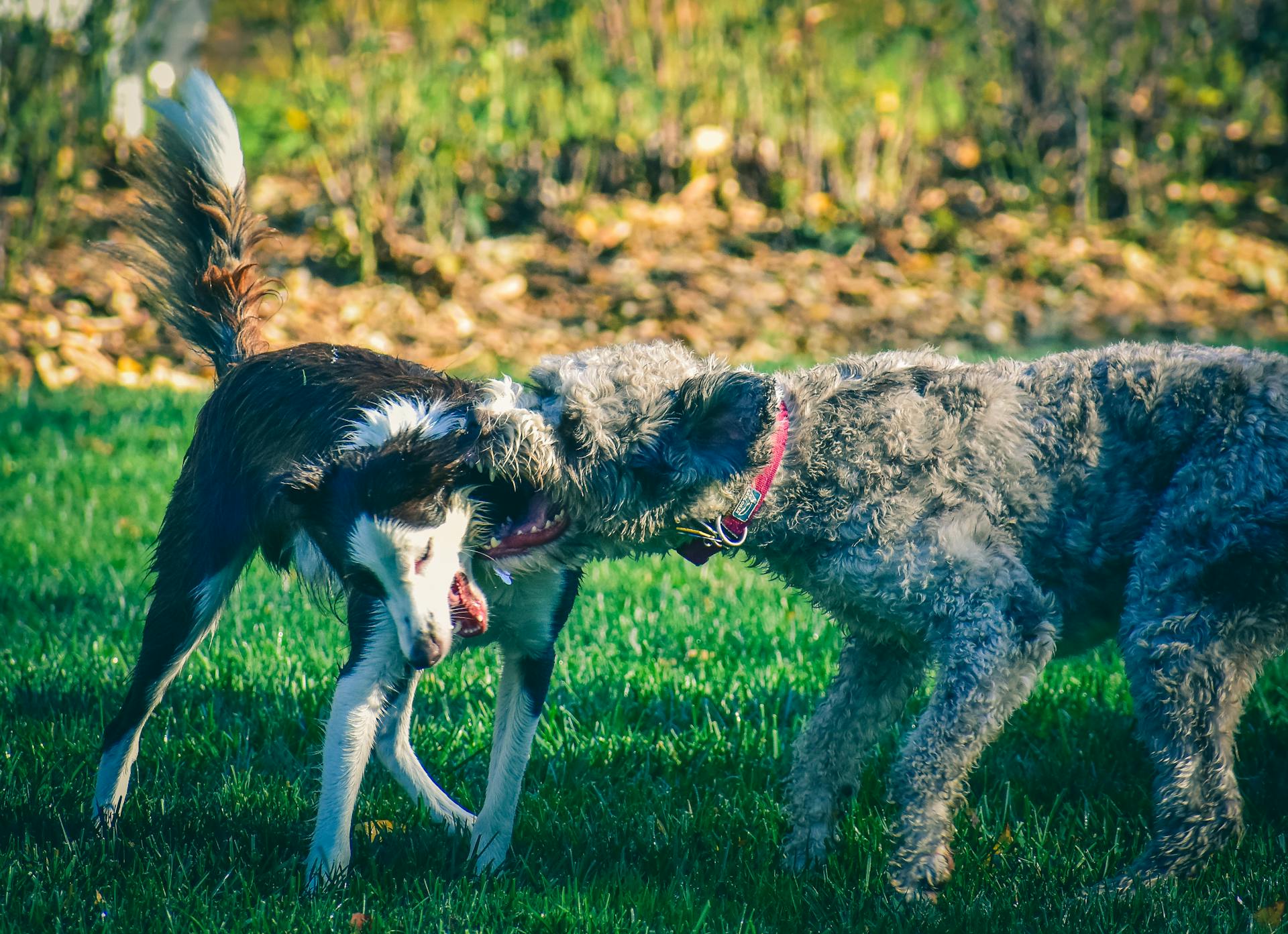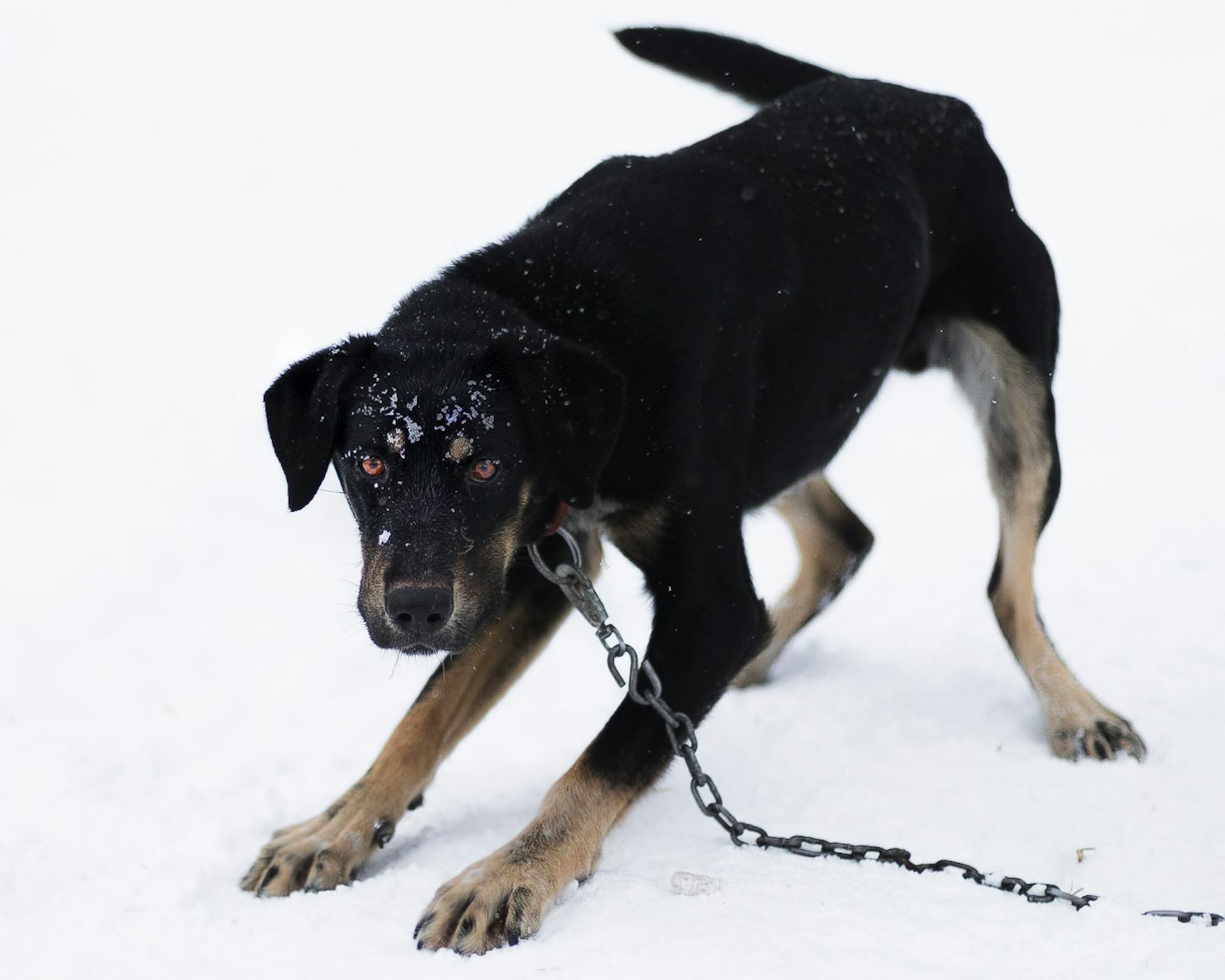
Dog food aggression is a common issue that can be challenging to manage. According to research, 25% of dogs exhibit resource guarding behavior, including food aggression.
Resource guarding is often a learned behavior, and it's essential to understand the underlying causes to address the issue effectively. This can include fear, anxiety, or past experiences.
In some cases, dogs may associate their food with a sense of security or comfort. For instance, a study found that dogs that were fed in a safe and quiet environment were less likely to develop resource guarding behavior.
Early intervention is key to managing dog food aggression. By recognizing the signs and taking steps to address the issue, you can help your dog feel more relaxed and secure during mealtime.
What Is Dog Food Aggression?
Dog food aggression is a common issue that can cause stress and anxiety for both dogs and their owners. It's a behavior where dogs become protective of their food and may growl, snap, or even bite when approached.
Resource guarding is a key factor in dog food aggression, and it can develop if dogs are not trained early on. This is especially true for adult dogs that may have already developed this behavior.
Tethering your dog to a heavy and durable object while feeding can help desensitize them to your presence around high-value items like food. This can be a useful technique, but it's essential to do it slowly and carefully.
If your dog gives you warning signals like stiffening their body or raising their lip, it means you're getting too close. Back off and try again when they're more relaxed.
The goal is to help your dog feel comfortable with you approaching their bowl, so take it slow and don't rush the process.
Causes and Prevention
Dog food aggression can stem from a dog learning this behavior accidentally at a very young age. It's essential to be aware of this possibility and take steps to prevent it from developing.
Some breeds have hereditary aggressive tendencies and may guard food due to their pack-like mentality. This means that certain breeds may be more prone to food aggression, so it's crucial to research and understand the temperament of a breed before bringing a dog home.
A dog can develop food aggression in a sheltered environment where they need to compete over limited resources. This is often the case in shelters where dogs may have to fight for food and attention.
Here are some common causes of food aggression:
Understanding the Roots
According to Patricia McConnell, Ph.D., resource guarding in dogs is also known as "possessive aggression." This means that a dog views possession of something, like a toy or a spot, as its own private property. From the dog's perspective, possession is nine-tenths of the law.
Resource guarding can start at a young age, and it's not just about food and toys. Some dogs may become protective of their beds or even the companionship of a preferred human.

There are several common causes of resource guarding. Some dogs may learn this behavior accidentally at a young age, while others may develop it in a sheltered environment where they need to compete over limited resources. Trauma, such as losing an owner or physical abuse, can also be a powerful trigger. Some breeds may even have hereditary aggressive tendencies and guard food due to their pack-like mentality.
Here are some common causes of resource guarding:
- A dog can learn this behaviour accidentally at a very young age.
- They can develop this behaviour in a sheltered environment where they need to compete over limited resources.
- Trauma such as losing their owner, physical abuse, fighting with another dog, or natural disasters are powerful triggers.
- Some breeds have hereditary aggressive tendencies and may guard food due to their pack-like mentality.
Before trying to address resource guarding, it's essential to rule out any underlying medical issues. A change in behavior or a sign of aggressive behavior may indicate the presence of an underlying medical issue. Consult a vet or animal behaviorist to put a treatment plan into place.
Feeding Schedules and Portion Control
Feeding Schedules and Portion Control can make a big difference in your dog's behavior and overall health. Some dogs benefit from multiple smaller meals throughout the day, which can help prevent intense hunger and aggressive food guarding behaviors.

Feeding your dog once a day can mimic their natural eating patterns, but it may increase food guarding in some dogs. This is because wild canines typically eat when they can, rather than following a strict schedule.
Twice daily feedings can provide regular nutrition and may reduce anxiety in some dogs. However, this requires a consistent schedule, which can be challenging for owners with busy lives.
Multiple small meals can be beneficial for dogs with digestive issues, as it can reduce food guarding and provide more frequent nutrition. However, this may be impractical for owners with hectic schedules.
Here's a quick reference guide to different feeding schedules and their potential benefits and considerations:
Recognizing Signs and Behaviors
Dogs display varying levels of food aggression, categorized into mild, moderate, and severe behaviors. Mild signs include verbal cues like growling, baring teeth, and raised hackles.
Mild signs of food aggression can be subtle, but they're a warning sign that your dog is uncomfortable with their food being approached. If you notice any of these behaviors, it's essential to address them before they escalate.
Moderate signs include snapping or lunging at people who come near their food. This behavior is a clear indication that your dog is feeling threatened.
Severe signs of food aggression are extremely concerning and can be life-threatening. They include biting or chasing people away from the feeding area.
To identify resource guarding, look for body language signs like stiffening of the body, hard stare, whale eye, lifting lips, low growling, and baring teeth. These signs can be subtle, but they're a warning sign that your dog is feeling threatened.
Here are some common signs of resource guarding in dogs:
- Stiffening of the body when someone approaches their food
- Raised hackles (the hair along the back standing up)
- Whale eye (showing the whites of their eyes)
- Ears pinned back
- Tail tucked or held very still
Escalating behaviors include snapping or lunging at people who come near their food, biting or attempting to bite when someone approaches during mealtime, chasing people away from the feeding area, and guarding empty food bowls or other food-related items.
Readers also liked: What Human Food Is Safe for Dogs
Training and Desensitization
Training and Desensitization is a crucial step in addressing dog food aggression. Proper training can help reduce or eliminate aggression, and desensitization can help your dog feel more comfortable with your presence around their food.
To start, you can try feeding your dogs in separate areas, gradually moving their feeding locations closer over time. This is a great way to help your dog get used to your presence around their food. You can also try adding food to their bowl while they eat, rather than taking it away, to help them associate your approach with a positive outcome.
Here are some specific steps you can follow to desensitize your dog to your presence around their food:
- Start by feeding the dogs in separate areas, gradually moving their feeding locations closer over time.
- While they eat, offer positive reinforcement like treats and praise for calm behavior.
- As they become more comfortable, you can try approaching their bowl while they eat and adding food to their bowl.
Remember to go at your dog's pace and avoid rushing the process, as this can make things worse. With patience and consistency, you can help your dog feel more comfortable and secure around their food.
Inadequate Training
Inadequate Training is a common pitfall that can lead to unwanted behaviors in dogs. Dogs that learn to associate human presence during mealtimes with positive experiences are less likely to develop food guarding behaviors.
Providing a stable and predictable environment through consistent training can go a long way in preventing behavioral issues. This includes establishing a routine for feeding times to avoid associating human presence with food.
A dog's early life experiences play a significant role in shaping their behavior, and inadequate training can have long-lasting effects. If a dog is not socialized and trained properly, they may become fearful or aggressive around strangers or in new situations.
Consistency is key when it comes to training, and setting clear boundaries and expectations can help prevent unwanted behaviors from developing. By doing so, you can create a strong foundation for a well-behaved and well-adjusted dog.
Desensitisation and Counterconditioning
Desensitisation and Counterconditioning is a powerful technique to help your dog feel more comfortable around food and other resources. It's a process of gradually exposing your dog to the thing that triggers their aggression, while associating it with positive experiences.
The goal is to help your dog learn that the presence of others around their food doesn't mean they're going to lose it. By doing this, you can prevent resource guarding from developing in the first place. Start by feeding your dogs in separate areas, and gradually move their feeding locations closer over time.
As they eat, offer positive reinforcement like treats and praise for calm behavior. This helps them associate the presence of other dogs with positive experiences. If there are no signs of aggression, you can allow them to eat in closer proximity gradually.
To make this process even more effective, try adding food to your dog's bowl when you approach, rather than taking it away. This will help your dog learn that your presence means food, not food loss. It's a simple yet powerful trick that can make a big difference in your dog's behavior.
Here are some key steps to keep in mind:
- Feed your dogs in separate areas and gradually move their feeding locations closer over time.
- Offer positive reinforcement like treats and praise for calm behavior.
- Add food to your dog's bowl when you approach, rather than taking it away.
Remember, patience and consistency are key when it comes to desensitisation and counterconditioning. It may take time for your dog to adjust to the new situation, but with persistence and positive reinforcement, you can help them feel more comfortable and confident around food and other resources.
Frequently Asked Questions
Should I punish my dog for food aggression?
No, punishing your dog for food aggression can create more fear and stress. Instead, use a force-free approach to help your dog feel more comfortable and confident around food.
How do I stop my dog from attacking my other dog?
Separate your dogs immediately if they start to fight, and consider desensitization training to help them coexist peacefully
Can food aggression in dogs be cured?
While food aggression in dogs can be challenging to overcome, it can be managed and reduced with proper training and behavior management. With the right approach, you can help your pup feel more comfortable and secure around food.
Can food aggression in dogs be cured?
Yes, food aggression in dogs can be managed and overcome with the right training program, but it requires patience, time, and a gradual approach. A desensitization and counterconditioning program can be highly effective in helping your dog overcome food aggression.
What to do when dogs fight over food?
To prevent dog food fights, feed each dog separately and establish a calm eating environment by following our simple guidelines. Start by implementing one dog per bowl and explore our other expert tips to ensure a peaceful mealtime.
Sources
- https://www.alphapaws.com/food-aggression-and-resource-guarding/
- https://companyofanimals.com/uk/food-aggression-in-dogs/
- https://apawlopets.com/blogs/apawlo/overcoming-dog-food-aggression-a-comprehensive-guide
- http://www.yorkiesunited.com/food-aggression.html
- https://www.akc.org/expert-advice/training/resource-guarding-in-dogs/
Featured Images: pexels.com


